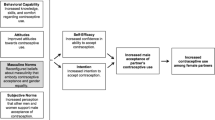Abstract
Excluding Hollerbach (1980), previous fertility researchers have paid little attention to contraceptive power bases, relationships that become the source of changes in birth control values and behavior. Eight contraceptive power bases, each evaluated as a direct or obvious strategy, were identified in a pilot study involving 25 college students as participants and 10 undergraduate raters. Two-hundred college students completed a questionnaire which included the Bem Sex Role Inventory, inquired into their sexual and contraceptive behavior, and asked about contraceptive power bases. There were highly significant main effects for both students' personal experiences with contraceptive power bases and for their opinions about the comfort and effectiveness of same. Coercion was the most popular and legitimate power was the least popular power base. Women were more likely than men to be the targets of contraceptive power bases, the majority of which were stereotyped as feminine by women in particular. Sex role identification was unrelated to students' experiences with contraceptive power bases. The implications of these findings for family-planning researchers and practioners are addressed.
Similar content being viewed by others
References
Allgeier, E. R. (1983). Reproduction, roles, and responsibilities. In E. R. Allgeier and N. B. McCormick (eds.),Changing Boundaries: Gender Roles and Sexual Behavior Mayfield, Palo Alto, CA, pp. 163–181.
Beck, J. G., and Davies, D. K. (1987). Teen contraception: A Review of perspectives on compliance.Arch. Sex. Behav. 16: 337–368.
Bem, S. L. (1974). The measurement of psychological androgyny.J. Consult. Clin. Psychol. 42: 155–162.
Bem, S. L. (1981).Bem Sex Role Inventory, Professional Manual Consulting Psychologists Press, Palo Alto, CA.
Falbo, T. (1977). Relationships between sex, sex role, and social influence.Psychol. Women Quart. 2: 62–72.
Falbo, T. (1982). PAQ types and power strategies used in intimate relationships.Psychol. Women Quart. 6: 399–405.
Falbo, T., and Peplau, L. A. (1980). Power strategies in intimate relationships.J. Pers. Soc. Psychol. 38: 618–628.
French, J. R. P., Jr., and Raven, B. (1959). The bases of social power. In D. Cartwright (ed.),Studies in Social Power University of Michigan Research Center for Group Dynamics, Institute for Social Research, Ann Arbor, pp. 150–167.
Furstenberg, F. F., Jr., Herceg-Baron, R., Shea, J., and Webb, D. (1984). Family communication and teenagers' contraceptive use.Fam. Plann. Perspect. 16: 163–170.
Herold, E. S., and McNamee, J. P. (1982). An explanatory model of contraceptive use among young single women.J. Sex Res. 18: 289–304.
Hollerbach, P. E. (1980). Power in families, communication, and fertility decision-making.Population Environ. 3: 146–173.
Johnson, P. (1976). Women and power: Toward a theory of effectiveness.J. Soc. Issues 32: 99–109.
Johnson, P. B., and Goodchilds, J. D. (1976, October). How women get their way.Psychol. Today, pp. 69–70.
Kisker, E. E. (1985). Teenagers talk about sex, pregnancy and contraception.Fam. Plann. Perspect. 17: 83–90.
Lips, H. (1981).Women, Men, and the Psychology of Power Prentice-Hall, Englewood Cliffs, NJ.
McCormick, N. B. (1979). Come-ons and put-offs: Unmarried students' strategies for having and avoiding sexual intercourse.Psychol. Women Quart. 4: 94–211.
McCormick, N. B. (1986). Encouraging rural youth to be sexually responsible.J. Sex Educ. Ther. 12: 28–31.
McCormick, N. B., and Jesser, C. J. (1983). The courtship game: Power in the sexual encounter. In E. R. Allgeier and N. B. McCormick (eds.),Changing Boundaries: Gender Roles and Sexual Behavior Mayfield, Palo Alto, CA, pp. 64–86.
Milan, R. J., Jr., and Kilmann, P. R. (1987). Interpersonal factors in premarital contraception.J. Sex Res. 23: 289–321.
Newcomer, S. F., and Udry, J. R. (1985). Parent-child communication and adolescent sexual behavior.Fam. Plann. Perspect. 17: 169–174.
Raven, B. H. (1965). Social influence and power. In I. D. Steiner and M. Fishbein (eds.),Current Studies in Social Psychology Holt, Rinehart and Winston, New York, pp. 371–382.
Rothenberg, P. B. (1980). Communication about sex and birth control between mothers and their adolescent children.Population Eviron. 3: 35–50.
Sack, A. R., Billingham, R. E., and Howard, R. D. (1985). Premarital contraceptive use: A discriminant analysis approach.Arch. Sex. Behav. 14: 165–182.
Author information
Authors and Affiliations
Additional information
Data presented in this article were collected in 1983 by Patricia Soja-Perrin for a master's thesis executed under the authors' strict direction and intensive supervision.
Rights and permissions
About this article
Cite this article
McCormick, N.B., Gaeddert, W. Power in college students' contraceptive decisions. Arch Sex Behav 18, 35–48 (1989). https://doi.org/10.1007/BF01579290
Issue Date:
DOI: https://doi.org/10.1007/BF01579290




